Friday, December 8, 2006
My ears! My ears!
Ack! Il Divo is on the Today show right now singing "Can't Live If Living Is without You" and sounding like an old car trying to start on a cold morning needing to be shot to be put out of its misery.
Sunday, December 3, 2006
Oklahoma organist
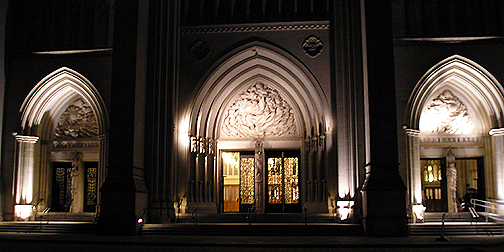
After Advent Lessons and Carols at the National Cathedral this evening, the cathedral presented John Daniel Schwandt in recital in their "Celebrity Organ Recital" series. Schwandt is the principal organ professor and director of the American Organ Institute at the University of Oklahoma in Norman. I've been anxious to meet him since he came to OU, since he has a very active vision as to the role of organists in modern music and how they need to be more than just church musicians. My friend John was in graduate school with Dr. Schwandt at Indiana University, too.
Once the service was over and the chancel cleared and rearranged, they allowed people to enter and sit in the Great Quire to listen to the concert. I knew better than that, because most visiting organists are enamoured of the enormous trompette-en-chamade over the high altar. For those unfamiliar with organs, the en-chamade is a division of long organ pipes with a trumpet-type bell at the end that are mounted horizontally instead of vertically; they are used for fanfares and festal occasions when one wants to blast a melody out over the full organ. Pipes like this in most churches are usually so loud that the congregation/audience jumps when they first hear it (I used to like to use it at the church where I used to work in Tulsa cause it made the babies cry).
Schwandt turned out to be a very good organist. His playing was crisp and precise, even in a lot of the difficult fast passages in some of the works. I also liked his registrations and the way he provided variety without making it sound like he was trying to demonstrate every sound on the organ. There were a couple of times his playing sounded out of alignment to me out in the nave, but they were notes played simultaneously from different ranks on the organ, so that may have been an illusion of sound due to the distance between pipes (keep in mind the cathedral is huge and the organ has over 10,650 pipes).
The recital opened with Marcel Dupré's transcription of J. S. Bach's Sinfonia from Cantata No. 29 "We Thank Thee, God." It's a familiar tune for those who listen to organ music now and then.
Next on the list was a set of Three Improvisations created by Schwandt. He said that they were going to be total improvisations and he hadn't pre-planned them. The first was done in the French classic style, the second in the German baroque style, and the third in the contemporary style. I absolutely loved the contemporary improvisation; think "Music from the Hearts of Space" on public radio, only with a melody. He then immediately segued into the French Romantic style with Alexandre Guilmant's March sur un Thème de Handel, Op. 15, No. 2.
The American entry in the recital was Calvin Hampton's Prayer and Alleluias from Three Pieces. Then concluding the formal part of the program was Maurice Dufuflé's tour-de-force, Prelude and Fugue on the name ALAIN, Op. 7.
Because the lesson and carols service delayed the start of the recital by half an hour, I had to slip out at that point. For an encore of sorts, Schwandt was going to solicit musical themes from the audience and play improvisations on them. As it was I just barely made it to the bus on time, having to run across the street to catch it as it pulled up to the stop.
I feel so devoted tonight. By going to lessons and carols and the recital, I missed the chance to play fan/paparazzo down at the Kennedy Center, where they were doing the Kennedy Center Honors show today (usually nationally broadcast Christmas week), and lots of people gather to catch a glimpse of the glitterati. The President and First Lady always go, plus all the dozens and dozens of celebrities. This year's honorees included Steven Spielberg, Lord Andrew Lloyd Webber, Dolly Parton, Zubin Mehta, and Smokey Robinson.
Oh, above and below are a couple of pictures I snapped of the exterior of the cathedral at night.
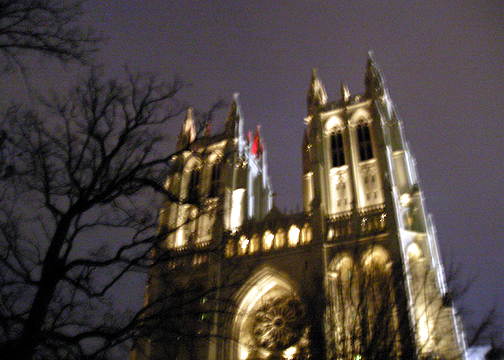
Friday, December 1, 2006
Ford's Theater
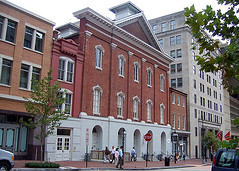
This is Ford's Theater, where Abraham Lincoln was shot. It's operated both as a historic site and a functioning theater (right now they're playing A Christmas Carol).
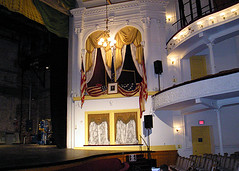 Here is the inside of the theater, looking towards the presidential box. You can see how an actor would have quick, easy access, and how he was able to escape by jumping out of the box onto the stage below. Note the seating in the lower right corner—the entire auditorium is filled with what look like free-standing dining room chairs.
Here is the inside of the theater, looking towards the presidential box. You can see how an actor would have quick, easy access, and how he was able to escape by jumping out of the box onto the stage below. Note the seating in the lower right corner—the entire auditorium is filled with what look like free-standing dining room chairs.
Saturday, November 18, 2006
Kazhakhstani film
After buying more stuff at Macy's and at H & M, Svet took me to dinner at Philadelphia Cheesesteak Factory (good, but really messy) and then to the movie theatre there at Tyson's Corner to see Borat: Cultural Learnings of America for Make Benefit Glorious Nation of Kazakhstan. Svet somehow managed to buy us two children's tickets on the ticket computer, and the ticket taker guy noticed it when we went in. Then we had to wait for some manager to come down so Svet could pay the price differential, which took forever.
The movie was very, very crude and absolutely outrageous. It was also shockingly hilarious. You know, I was at that Gay Pride parade in D.C. (I was closely scanning the screen to see if I'd been captured on film). And I've been in a fraternity (though not in South Carolina...our guys weren't fat slobs like that), I've been to yard sales, I've been to rodeos, I've been to Pentecostal church services, and I've even known Southern ladies who teach Gracious Living and who throw proper dinner parties....I don't see why all those people are suing.....I mean, their portrayals were really pretty accurate as to every day reality in the South. From the movie criticism standpoint, it went pretty well, but they didn't know how to bring it to a good conclusion. The story arc, as it were, was rather lacking. Consequently, I'm not going to be nominating it for any Oscars.
The movie was very, very crude and absolutely outrageous. It was also shockingly hilarious. You know, I was at that Gay Pride parade in D.C. (I was closely scanning the screen to see if I'd been captured on film). And I've been in a fraternity (though not in South Carolina...our guys weren't fat slobs like that), I've been to yard sales, I've been to rodeos, I've been to Pentecostal church services, and I've even known Southern ladies who teach Gracious Living and who throw proper dinner parties....I don't see why all those people are suing.....I mean, their portrayals were really pretty accurate as to every day reality in the South. From the movie criticism standpoint, it went pretty well, but they didn't know how to bring it to a good conclusion. The story arc, as it were, was rather lacking. Consequently, I'm not going to be nominating it for any Oscars.
Thursday, November 16, 2006
Musical research
Researchers at the University of Newcastle upon Tyne are conducting an investigation on listening to music. To help them out and take a quick little test, go to:
http://www.delosis.com/listening/home.html
http://www.delosis.com/listening/home.html
Tuesday, November 14, 2006
Mirren's The Queen
Twenty-five years ago a small group of my friends got together very early one morning, donned morning suits and our lady friends donned hats and gloves, and gathered at my apartment at 4 a.m. for a special festive English breakfast, complete with champagne. We huddled around the television to watch the nuptial ceremonies of the Lady Diana Spencer and HRH the Prince of Wales, reveling in the processions, the dress, the cathedral, the music, and all of the pageantry that only the British can do. One of my friends was there in St. Paul's Cathedral, too, where she was part of the choir.
Nine years ago, I was one of those people glued to the television set when the news of an automobile crash in a Parisian tunnel hit CNN, soon to hear the tragic news of the Princess's death. I joined with my good friend Lord Darlow in grieving the loss of his cousin and in cursing the press and paparazzi for their contributions to this terrible event. Naturally, the following weekend I arose early in the morning once again to watch the funeral processions and the state funeral from Westminster Abbey. Certainly, I was a Diana fan, and I'm also a confirmed monarchist.
It was with this background that I was dragged into the E Street Theater Sunday night to watch the new motion picture, The Queen.
The critics have been praising this film and the studio has been promoting the usual Oscar hype for the movie's star, Dame Helen Mirren. I'm not a regular movie-goer, so the trailers I had seen for the film were very limited; thus, I was not exactly sure of the content of the movie, not knowing if it was a biography of Her Majesty or a modern portrayal.
As it turns out, the movie is a historical docudrama of sorts recounting the days between the death of the Princess and the funeral, attempting to show the Queen's and the royal family's reaction and response to the events of the day, as well as the continuing political machinations of then-new prime minister, Tony Blair. Woven in and out of the movie was news footage featuring the late Princess, the French papparazzi, her wedding, and her funeral. What concerns me about the movie is that it portrays the featured events as literal fact. Now, I've certainly not researched the matter, but I'm not aware of diaries, recordings, or reports from the involved parties as to exactly what was thought, done, and said during those days; I suspect that a great deal of artistic license was taken.
Dame Helen appears in practically all of the movie. She appears rather dour and at times almost petulant. In portraying the Queen's strong sense of duty and royal decorum, she makes the Queen appear distant and unsympathetic, even in those scenes designed to elicit sympathy. Interestingly, Dame Helen previously played Elizabeth I in last year's television drama of the same name and Queen Charlotte in The Madness of King George.
Counterbalancing the Queen in the story is the newly elected Tony Blair, played by Micheal Sheen, who seems rather an opportunistic, shallow, out-of-his-league boy married to a bitter and anti-monarchist wife. Alex Jennings plays the Prince of Wales, and the movie makes him out to be quite the spineless, indecisive whimp. Filling out the cast are James Cromwell as a blustering, grumpy Duke of Edinburgh and Sylvia Sims as an essentially inconsequential Queen Mother.
Some of the cinematography was beautiful, especially in those scenes shot in the gorgeous Scottish Highland. The set designs and most especially the costumes were all fabulous.
The whole storyline of the real life public reaction to Diana's death has always puzzled me. The royal family's and the Spencer family's initial response to the death was, I think, the correct thing to do. They wanted it to be a private family matter for a person who had been hounded by the press and public during her marriage. And, the death of a royal divorcée—a former HRH, as they called it—had no precedent in public royal mourning. It certainly seemed to me that the tasteful, dignified thing was to have private family rites and not a grand public event. And yet the public had this illogical, unexpected outpouring of public grief, holding candlelight vigils outside the royal castles, bringing tens of thousands of floral offerings to lay outside the gates, and depositing all kinds of memorabilia in memory of a dead divorcée. This demonstration of grief has set the precedent for all kinds of public displays for common people all over the world. Yet, whether it was the Princess of Wales, a rock star, or some person whose death made the news, I cannot see why the public should be emoting as though the never-met deceased were their dearest and closest family member.
The movie explored this public reaction, and alluded somewhat to the insidious role of the 24-hour news media and the tabloid press in fueling the evolution of public opinion and behavior. That, perhaps, is the one redeeming value of this movie.
Anglophiles and Diana fans will all no doubt want to see this movie. Others probably will find it a bit sleepy. But as for Academy Awards? I dunno. Perhaps. But it will depend upon the competition and whether or not any truly good movies are released in 2006.
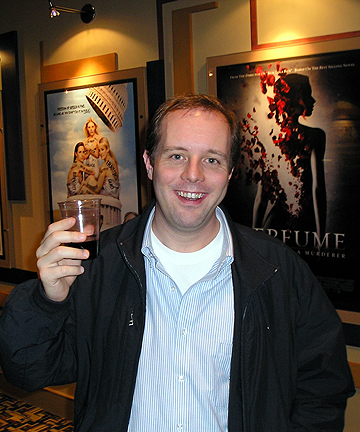
Matt's Kody Pose with the shiraz at the theater
Nine years ago, I was one of those people glued to the television set when the news of an automobile crash in a Parisian tunnel hit CNN, soon to hear the tragic news of the Princess's death. I joined with my good friend Lord Darlow in grieving the loss of his cousin and in cursing the press and paparazzi for their contributions to this terrible event. Naturally, the following weekend I arose early in the morning once again to watch the funeral processions and the state funeral from Westminster Abbey. Certainly, I was a Diana fan, and I'm also a confirmed monarchist.
It was with this background that I was dragged into the E Street Theater Sunday night to watch the new motion picture, The Queen.
The critics have been praising this film and the studio has been promoting the usual Oscar hype for the movie's star, Dame Helen Mirren. I'm not a regular movie-goer, so the trailers I had seen for the film were very limited; thus, I was not exactly sure of the content of the movie, not knowing if it was a biography of Her Majesty or a modern portrayal.
As it turns out, the movie is a historical docudrama of sorts recounting the days between the death of the Princess and the funeral, attempting to show the Queen's and the royal family's reaction and response to the events of the day, as well as the continuing political machinations of then-new prime minister, Tony Blair. Woven in and out of the movie was news footage featuring the late Princess, the French papparazzi, her wedding, and her funeral. What concerns me about the movie is that it portrays the featured events as literal fact. Now, I've certainly not researched the matter, but I'm not aware of diaries, recordings, or reports from the involved parties as to exactly what was thought, done, and said during those days; I suspect that a great deal of artistic license was taken.
Dame Helen appears in practically all of the movie. She appears rather dour and at times almost petulant. In portraying the Queen's strong sense of duty and royal decorum, she makes the Queen appear distant and unsympathetic, even in those scenes designed to elicit sympathy. Interestingly, Dame Helen previously played Elizabeth I in last year's television drama of the same name and Queen Charlotte in The Madness of King George.
Counterbalancing the Queen in the story is the newly elected Tony Blair, played by Micheal Sheen, who seems rather an opportunistic, shallow, out-of-his-league boy married to a bitter and anti-monarchist wife. Alex Jennings plays the Prince of Wales, and the movie makes him out to be quite the spineless, indecisive whimp. Filling out the cast are James Cromwell as a blustering, grumpy Duke of Edinburgh and Sylvia Sims as an essentially inconsequential Queen Mother.
Some of the cinematography was beautiful, especially in those scenes shot in the gorgeous Scottish Highland. The set designs and most especially the costumes were all fabulous.
The whole storyline of the real life public reaction to Diana's death has always puzzled me. The royal family's and the Spencer family's initial response to the death was, I think, the correct thing to do. They wanted it to be a private family matter for a person who had been hounded by the press and public during her marriage. And, the death of a royal divorcée—a former HRH, as they called it—had no precedent in public royal mourning. It certainly seemed to me that the tasteful, dignified thing was to have private family rites and not a grand public event. And yet the public had this illogical, unexpected outpouring of public grief, holding candlelight vigils outside the royal castles, bringing tens of thousands of floral offerings to lay outside the gates, and depositing all kinds of memorabilia in memory of a dead divorcée. This demonstration of grief has set the precedent for all kinds of public displays for common people all over the world. Yet, whether it was the Princess of Wales, a rock star, or some person whose death made the news, I cannot see why the public should be emoting as though the never-met deceased were their dearest and closest family member.
The movie explored this public reaction, and alluded somewhat to the insidious role of the 24-hour news media and the tabloid press in fueling the evolution of public opinion and behavior. That, perhaps, is the one redeeming value of this movie.
Anglophiles and Diana fans will all no doubt want to see this movie. Others probably will find it a bit sleepy. But as for Academy Awards? I dunno. Perhaps. But it will depend upon the competition and whether or not any truly good movies are released in 2006.

Matt's Kody Pose with the shiraz at the theater
Monday, November 13, 2006
An afternoon on the Mall
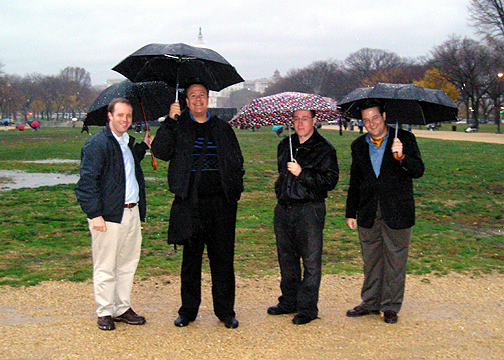
Alas. Sunday it rained all day. After three days of gorgeous, unseasonably warm days, the cold front moved through yesterday and we had constant mist and drizzle with the occasional outright downpour. Ordinarily, fall rain isn't a problem. But, yesterday was the day of Washington National Opera's annual simulcast on the Mall, this year of Madama Butterfly. Alas.

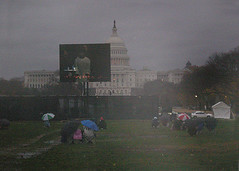
As you can see, attendance was down a little bit this year.
Last year during the simulcast of Porgy and Bess, there were probably between 12,000 and 15,000 people there for the performance, sitting on the grass, picnicking, and otherwise enjoying what was then a beautiful, sunny, fall afternoon. This year, though, between the rain, temperatures in the 40s, and a cold, piercing wind, there were maybe only 12 to 15 people there for the performance. Such a shame. The opera spent a lot of money getting the screen set up, arranging for what amounted to private port-a-potties for each attendee, security, publicity, and so forth. I just hope they continue the tradition next year!
So, Matt and Robert not being the outdoorsy, hearty types willing to endure harsh weather and adversity like Jon and me (LOL), we opted for an indoor activity, and headed to the Sackler Gallery for the afternoon. The Sackler Gallery, along with the next-door Freer Gallery, is the Smithsonian's National Museum of Asian Art. We went particularly to see their current exhibition, "In the Beginning: Bibles before the Year 1000." And, yesterday afternoon, there was a special lecture demonstration related to the exhibit called "The Aleppo Codex: Chanting the Hebrew Scriptures," featuring a cantor from Baltimore who spent more time discussing notational esoterica than he did chanting. Following the lecture, we went to the Bible exhibit, which was in a really dark, ticket-only-for-admission gallery. Many of the books and page fragments were quite pretty. Of course, the early things in Aramaic, Arabic, Hebrew, and Greek I couldn't read; I was chagrinned, though, that I really couldn't read the Latin books and pages because I couldn't read the handwriting!
After we left the Sackler, we walked down towards the Capitol where the opera simulcast was taking place and stood in the rain long enough to hear the Humming Chorus and the end of act two. Then the guys were getting peckish from lack of food, so we popped into the National Museum of the American Indian and headed to Mitsisam, their cafeteria specializing in American Indian foods from across the continent.
Friday, November 10, 2006
Anthem and incense
During All Saints Day's solemn high mass at St. Paul's K Street, I videoed the anthem during the offertory and planned to post it here for you all to see in my post that night. For some reason, I couldn't get it to play once I uploaded it to my computer, and neither Ryan nor Jean could fix the file, either, but finally Svet came to our rescue and "zipped" the video on my camera's memory card and pulled it off that way; now it works. Thanks, Svet!
So, at long last, here is the Choir of St. Paul's Episcopal Church singing Edgar Bainton's "And I Saw a New Heaven." Forgive the cinematography; this was a "surreptitious" recording on my little point-and-click digital camera primarily to capture the sound, not to be a pretty picture. An added plus to the video is you get to watch the incensation of the altar in the traditional high church style.
About three minutes in to the video, the tenors introduce a new melodic theme whilst singing the words, "And God shall wipe away all tears from their eyes," that continues through the end of the anthem; I've long thought this was one of the most hauntingly beautiful melodies in the post-Anglican Revival musical literature.
So, at long last, here is the Choir of St. Paul's Episcopal Church singing Edgar Bainton's "And I Saw a New Heaven." Forgive the cinematography; this was a "surreptitious" recording on my little point-and-click digital camera primarily to capture the sound, not to be a pretty picture. An added plus to the video is you get to watch the incensation of the altar in the traditional high church style.
About three minutes in to the video, the tenors introduce a new melodic theme whilst singing the words, "And God shall wipe away all tears from their eyes," that continues through the end of the anthem; I've long thought this was one of the most hauntingly beautiful melodies in the post-Anglican Revival musical literature.
Sunday, November 5, 2006
Kennedy Center concert
The National Symphony Orchestra was in fine form Friday night under the baton of guest conductor and internationally-acclaimed violinist Pinchas Zukerman, performing in the Concert Hall of the Kennedy Center for the Performing Arts here in Washington.
Opening with the Prélude to Richard Wagner's opera, Die Meistersinger von Nürnberg, they displayed a wonderful richness of tone and some of the finest playing I think I've heard them do in the past few years. The strings bowed in unison, the woodwinds were always together (and there are some challenging solo spotlights for the winds as an ensemble in this prelude), and the brass was right on cue and didn't have any unfortunate splatty entrances. As expected for a Wagner work, the usual orchestra was augmented; they had a huge, inspiring sound. This has always been one of my favorite classical pieces, and I love the grandiosity and nobility of the music.
Zuckerman's wife, Amanda Forsyth, appeared in the second selection as the featured cello soloist in Max Bruch's Kol nidrei, Adagio on Hebrew Melodies for Cello and Orchestra, Op. 47. There was actually very little for the orchestra to do in this piece, with the vast majority being solo cello. Forsyth plays a 1699 vintage Carlo Giuseppe Testore instrument that was wonderfully expressive in the upper registers and lush in the middle range, but a little raspy, I thought, in the lowest ranges. The Bruch only lasted about ten minutes, and I would have liked to have had more time to hear Forsyth's playing.
Equally entertaining as listening to the music was observing what the 38-year-old blonde South African was wearing. She emerged carrying her cello clad in a tightly form-fitting long fire engine red dress with a high neckline, tight long sleeves, gathered fabric crossed in front at the waist, and a fish tail flair at the bottom. She accessorized with metallic silver shoes with four-inch spike heels and lots of diamond jewelry. She had great big stones for her drop earrings that really caught the light. She was also wearing quite a large wedding ring on her right hand (string players wear their rings on that hand to avoid damaging their instruments) and had a diamond tennis bracelet on that arm. She also wore a thin silver headband across the top of her head that had something on it that caught the light now and then, but it didn't look like it would have been a row of diamonds, so I don't know what that was.
The third work in the first half of the concert was Mozart's Violin Concerto No. 5 in A Major, K. 219, with Zuckerman as both conductor and featured soloist. The concerto is a fairly short work with only three movements. He performed admirably, particularly on the cadenzas at the end of each movement. What particularly displayed his renowned artistry, though, were those pianissimo passages he played, spellbinding the audience.
In fairness, I should comment upon his attire as well. He wore a black tail coat with black trousers. Instead of wearing a white bow tie and a white piqué waistcoat, however, he chose to wear a wide black cummerbund and he had this rather unusual white shirt designed to be worn without a tie that had rather stylized collar points and what almost looked like a fold-over lapel. And, since I last saw him in 2000 (his daughter and I sang the world premiere of an opera by Jean-Michel Damase), his hair has gone fully silver.
After the interval, the orchestra played Beethoven's Symphony No. 2 in D Major, Op. 36. Twas four movements, but only lasted about half an hour.
It was quite an enjoyable evening, and the NSO played excellently. This was a perfect example of what I've said for years, and that's that the NSO doesn't play well for their music director, Leonard Slatkin, and they only do well with respected guest conductors like Zuckerman. I kept looking for something to mention that was off key or not together or something all night long, and about the only thing I could note was that during a rather raucous section of the Beethoven, some of the bass players were slapping their strings a little bit with their bows and I could hear the slap.
Opening with the Prélude to Richard Wagner's opera, Die Meistersinger von Nürnberg, they displayed a wonderful richness of tone and some of the finest playing I think I've heard them do in the past few years. The strings bowed in unison, the woodwinds were always together (and there are some challenging solo spotlights for the winds as an ensemble in this prelude), and the brass was right on cue and didn't have any unfortunate splatty entrances. As expected for a Wagner work, the usual orchestra was augmented; they had a huge, inspiring sound. This has always been one of my favorite classical pieces, and I love the grandiosity and nobility of the music.
Zuckerman's wife, Amanda Forsyth, appeared in the second selection as the featured cello soloist in Max Bruch's Kol nidrei, Adagio on Hebrew Melodies for Cello and Orchestra, Op. 47. There was actually very little for the orchestra to do in this piece, with the vast majority being solo cello. Forsyth plays a 1699 vintage Carlo Giuseppe Testore instrument that was wonderfully expressive in the upper registers and lush in the middle range, but a little raspy, I thought, in the lowest ranges. The Bruch only lasted about ten minutes, and I would have liked to have had more time to hear Forsyth's playing.
Equally entertaining as listening to the music was observing what the 38-year-old blonde South African was wearing. She emerged carrying her cello clad in a tightly form-fitting long fire engine red dress with a high neckline, tight long sleeves, gathered fabric crossed in front at the waist, and a fish tail flair at the bottom. She accessorized with metallic silver shoes with four-inch spike heels and lots of diamond jewelry. She had great big stones for her drop earrings that really caught the light. She was also wearing quite a large wedding ring on her right hand (string players wear their rings on that hand to avoid damaging their instruments) and had a diamond tennis bracelet on that arm. She also wore a thin silver headband across the top of her head that had something on it that caught the light now and then, but it didn't look like it would have been a row of diamonds, so I don't know what that was.
The third work in the first half of the concert was Mozart's Violin Concerto No. 5 in A Major, K. 219, with Zuckerman as both conductor and featured soloist. The concerto is a fairly short work with only three movements. He performed admirably, particularly on the cadenzas at the end of each movement. What particularly displayed his renowned artistry, though, were those pianissimo passages he played, spellbinding the audience.
In fairness, I should comment upon his attire as well. He wore a black tail coat with black trousers. Instead of wearing a white bow tie and a white piqué waistcoat, however, he chose to wear a wide black cummerbund and he had this rather unusual white shirt designed to be worn without a tie that had rather stylized collar points and what almost looked like a fold-over lapel. And, since I last saw him in 2000 (his daughter and I sang the world premiere of an opera by Jean-Michel Damase), his hair has gone fully silver.
After the interval, the orchestra played Beethoven's Symphony No. 2 in D Major, Op. 36. Twas four movements, but only lasted about half an hour.
It was quite an enjoyable evening, and the NSO played excellently. This was a perfect example of what I've said for years, and that's that the NSO doesn't play well for their music director, Leonard Slatkin, and they only do well with respected guest conductors like Zuckerman. I kept looking for something to mention that was off key or not together or something all night long, and about the only thing I could note was that during a rather raucous section of the Beethoven, some of the bass players were slapping their strings a little bit with their bows and I could hear the slap.
Saturday, October 21, 2006
Put this on your calendar
For immediate release
Contact: Angela Olson, 202.295.2468
Washington National Opera’s
Second Annual Simulcast on National Mall
Public Invited to Free Performance of
Puccini’s Madama Butterfly
Sunday, November 12 at 2:00 p.m.
Washington National Opera—the nation’s opera company—will present a special bigscreen simulcast performance of Puccini’s Madama Butterfly on the National Mall on Sunday, November 12 at 2:00 p.m. WNO will transmit the performance of Butterfly live from the Kennedy Center stage to a huge 18' x 32' LED video screen located near the U.S. Capitol. The simulcast is expected to draw one of the nation’s largest known opera audiences and is part of WNO’s continuing commitment to broadcast one opera on the Mall each year, following the company’s groundbreaking simulcast of Gershwin’s Porgy and Bess in November 2005, which attracted over 13,000 in attendance.
“This is our continued demonstration of the company’s ongoing commit ment to bring opera to all audiences, exemplified by our recent, soldout Welcome to Opera Concert and our Generation O program, offering discounted tickets and special events for 18—35 year olds,” said John Pohanka, Chairman of the Board for Washington National Opera.
Thousands of people are expected to gather for the spectacular performance of Puccini’s legendary opera, highlighted by such melodies as “Un bel dì,” the “Flower Duet,” and the “Humming Chorus,” and featuring an outstanding cast led by internationally renowned singers Tatiana Borodina and Arturo ChacónCruz. The free performance is a gift from the Trustees and other underwriters of Washington National Opera to the citizens of Washington, D.C. No tickets are necessary.
Last year’s wildly successful simulcast of Porgy and Bess drew a crowd of 13,000 people of all ages to the Mall and met with resounding praise from the Washington community. The 2005 simulcast of Porgy and Bess marked the first time a live performance had ever been transmitted to the Mall. Combined with the live audience in the Kennedy Center Opera House, the over 15,000 total viewers made up the largest single audience in WNO’s 50 year history.
“Washington National Opera is thrilled to continue to find new ways of bringing opera to anyone. With our overwhelming success of last season’s simulcast, we are confident our Butterfly simulcast will draw another large and enthusiastic audience,” said Plácido Domingo, General Director of Washington National Opera.
Polish director Mariusz Trelinski’s production of Madama Butterfly was mounted by Washington National Opera in 2001 to popular and critical acclaim. Tim Smith of The Baltimore Sun and Opera News called the 2001 production “gripping theater....Removed from its usual sentimental, picture-postcard environs, this Madama Butterfly soars in new ways that likely will have audiences thinking and debating for a long time to come.” Written by Giacomo Puccini, Madama Butterfly premiered at Teatro alla Scala, Milan in 1904 and is considered one of the greatest masterpieces of Italian opera and one of the most beloved operas of all time.
For more information on the screening of Madama Butterfly on the Mall please call 202.295.2400 or visit www.dcopera.org. Regular performances at the Kennedy Center Opera House will take place November 4 (7:00 p.m.), 7 (7:30 p.m.), 9 (7:30 p.m.), 11 (7:00 p.m.), 12 (2:00 p.m.), 13 (7:00 p.m.), 15 (7:30 p.m.), 16 (7:30 p.m.), and 19 (2:00 p.m.). All programs, artists, and dates are subject to change.
American Airlines is the Official Airline of Washington National Opera.
# # #
_________________________
You may recall my blog post last year when I went to the outdoor Porgy and Bess simulcast and had a great time. I may actually pack a picnic basket for this year's performance! Trevor Ian, my spitz/beagle, unfortunately, is previously engaged in Oklahoma and will not be able to appear.
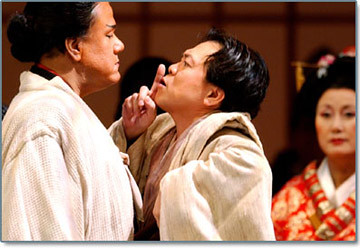
Copyright 2004 World Publishing Company. All rights reserved. Photo credits: KELLY KERR
This is me the last time I sang a Butterfly
Contact: Angela Olson, 202.295.2468
Second Annual Simulcast on National Mall
Public Invited to Free Performance of
Puccini’s Madama Butterfly
Sunday, November 12 at 2:00 p.m.
Washington National Opera—the nation’s opera company—will present a special bigscreen simulcast performance of Puccini’s Madama Butterfly on the National Mall on Sunday, November 12 at 2:00 p.m. WNO will transmit the performance of Butterfly live from the Kennedy Center stage to a huge 18' x 32' LED video screen located near the U.S. Capitol. The simulcast is expected to draw one of the nation’s largest known opera audiences and is part of WNO’s continuing commitment to broadcast one opera on the Mall each year, following the company’s groundbreaking simulcast of Gershwin’s Porgy and Bess in November 2005, which attracted over 13,000 in attendance.
“This is our continued demonstration of the company’s ongoing commit ment to bring opera to all audiences, exemplified by our recent, soldout Welcome to Opera Concert and our Generation O program, offering discounted tickets and special events for 18—35 year olds,” said John Pohanka, Chairman of the Board for Washington National Opera.
Thousands of people are expected to gather for the spectacular performance of Puccini’s legendary opera, highlighted by such melodies as “Un bel dì,” the “Flower Duet,” and the “Humming Chorus,” and featuring an outstanding cast led by internationally renowned singers Tatiana Borodina and Arturo ChacónCruz. The free performance is a gift from the Trustees and other underwriters of Washington National Opera to the citizens of Washington, D.C. No tickets are necessary.
Last year’s wildly successful simulcast of Porgy and Bess drew a crowd of 13,000 people of all ages to the Mall and met with resounding praise from the Washington community. The 2005 simulcast of Porgy and Bess marked the first time a live performance had ever been transmitted to the Mall. Combined with the live audience in the Kennedy Center Opera House, the over 15,000 total viewers made up the largest single audience in WNO’s 50 year history.
“Washington National Opera is thrilled to continue to find new ways of bringing opera to anyone. With our overwhelming success of last season’s simulcast, we are confident our Butterfly simulcast will draw another large and enthusiastic audience,” said Plácido Domingo, General Director of Washington National Opera.
Polish director Mariusz Trelinski’s production of Madama Butterfly was mounted by Washington National Opera in 2001 to popular and critical acclaim. Tim Smith of The Baltimore Sun and Opera News called the 2001 production “gripping theater....Removed from its usual sentimental, picture-postcard environs, this Madama Butterfly soars in new ways that likely will have audiences thinking and debating for a long time to come.” Written by Giacomo Puccini, Madama Butterfly premiered at Teatro alla Scala, Milan in 1904 and is considered one of the greatest masterpieces of Italian opera and one of the most beloved operas of all time.
For more information on the screening of Madama Butterfly on the Mall please call 202.295.2400 or visit www.dcopera.org. Regular performances at the Kennedy Center Opera House will take place November 4 (7:00 p.m.), 7 (7:30 p.m.), 9 (7:30 p.m.), 11 (7:00 p.m.), 12 (2:00 p.m.), 13 (7:00 p.m.), 15 (7:30 p.m.), 16 (7:30 p.m.), and 19 (2:00 p.m.). All programs, artists, and dates are subject to change.
American Airlines is the Official Airline of Washington National Opera.
_________________________
You may recall my blog post last year when I went to the outdoor Porgy and Bess simulcast and had a great time. I may actually pack a picnic basket for this year's performance! Trevor Ian, my spitz/beagle, unfortunately, is previously engaged in Oklahoma and will not be able to appear.

Copyright 2004 World Publishing Company. All rights reserved. Photo credits: KELLY KERR
This is me the last time I sang a Butterfly
Tuesday, September 19, 2006
Celebrity sightings
Last night Svet and I were browsing at the Barnes and Noble in Georgetown when Ben Stein—movie star, game show host, and former Nixon speechwriter—came in with a friend to shop.
Now, envision this:
Now, envision this:
Svet: (loud whisper) "Ask him to say 'Bueller"! Ask him to say 'Bueller'!"
Stein: (turning, drolly) "Bueller."
Monday, August 28, 2006
Bells and blossoms

A butterfly sups on a yellow rose in the Bishop's Garden.
Ryan and I went to the National Cathedral yesterday and took a bunch of photos in the cathedral gardens. For your listening enjoyment, here's a little YouTube clip of the cathedral carillon (bells) ringing after Mass. My purpose was to capture the sound, not to give you a pretty video to watch, so please be kind! :-) Also, sorry about some of the wind noise that got captured during the recording.
Carillon music
Sunday, August 13, 2006
Not an ambient fan
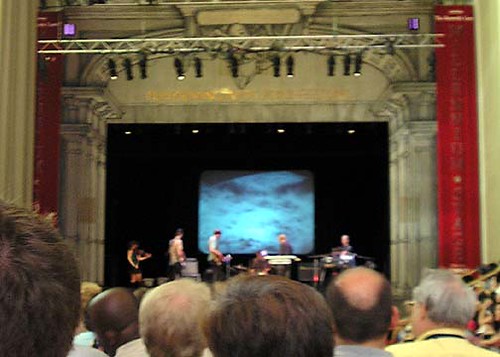
Sometimes when I listen to the current crop of new popular music, I start to think I'm getting old.
Yet, last night at the Kennedy Center's Millennium Stage, as I listened in bewilderment to the band Gregor Samsa, I quickly saw that I wasn't the only person lacking appreciation for the band's signature sound, some of whom were significantly younger than me.
Gregor Samsa is a seven-member Richmond, Va.,-based band in the inde rock (independent) genre blended with the sound of ambi rock (ambient music) that reportedly played a recent European tour to packed houses. Their members play percussion, keyboards, guitar, bass, violin, and vocals while a film played on a screen behind them.
The problem with this band is their "ambient" sound isn't even good background music/noise. When they were first introduced and came out on stage, they fiddled with their equipment for a while and some of the instruments started making some soft sounds that seemed so random, I wasn't sure if they were tuning or what. After this "tuning" had gone on for five minutes or so, I, as well as much of the audience, began to shift in our seats and get somewhat uncomfortable.
This soft, unexciting background noise went on for some time. Eventually there was a bit of a crescendo into some actual music that not only could be heard but that actually had vestiges of harmony and recognizable form, but that sound quickly disissipated and the music fell back into the boring "tuning" sound.
Well, after the first song, Ryan was bored and ready to go. All of the Africans/African-Americans in the audience seemed to get up and leave at this point, too. Thinking that the band just had a bad grasp of style, drama, and showmanship, with no one to guide them in laying out a live concert performance, I persevered in sitting through another song. Well, the second song was more of the same; but, it got worse: as the vocalist sang, the violin accompanied her, and the violin was flat! Painfully flat! It drove me crazy! At the conclusion of that song, I was more than happy to move along.
The Millennium Stage is the Kennedy Center's daily free concert series that takes place on a stage in one end of the Grand Foyer. Generally they feature contemporary, folk, international, and other types of music and performing arts which are not usually featured in one of the main (and expensive) performance venues in the Center. The quality and interestingness of the concerts varies widely, though usually the Saturday night performances are pretty good. I guess I'll never know if Gregor Samsa lived up to that reputation.
Tuesday, July 4, 2006
Capitol Fourth

Did you see me on television tonight?
We were at the Capitol Fourth concert tonight on the west steps of the Capitol. which was broadcast live on PBS. There was a great big "jumbotron" screen over the stage which showed the audience the television feed, and there were a lot of shots of the Capitol and close-ups of the fountain level, which is where we were sitting. They said that there were over 400,000 people on the Mall tonight.

We almost didn't go tonight. About 5:30, when we were planning to go to the Mall, there was a major thunderstorm that pounded through town. There're a lot of tree branches and stuff down and we had a brief period of BB sized hail. The Park Police had to herd all of the people on the Mall at that time into tents and into various Smithsonian museums to get them out of the rain, high winds, and lightening. The storm was fairly short, though, and the sun came out pretty quickly, so we Metroed on down to the Mall.
The entire Mall was in a "security area," so we had to have our bags inspected and go through a magnetometer before we were admitted. The entire two miles of the Mall was packed with all kinds of fair-like tents and activities, but we had to go down to the Capitol where the concert was going to be. After pulling some strings to get into the secured area in front of the stage and on the Capitol steps, we found our spot. They were giving away little American flags to everyone.

The concert featured the National Symphony Orchestra Pops and the Choral Arts Society of Washington with Erich Kunzel on the podium. They had a lot of special guest entertainers. Jason Alexander (Seinfeld) was the host and he did some song and dance numbers with some uncredited dancers. A teen pop singer called JoJo sang the national anthem. Vanessa Williams sang that Pocahontas song everybody sings, then she was joined by the puppet Elmo. Elmo "sang" with Vanessa and then did a couple of songs of his own and he was on way too long, but I suppose they were trying to appeal to the little kids in the audience. Michael Bolton showed up next to sing a Frank Sinatra song and another song in the style of Ray Charles (and he was on too long, too!). He was followed by a country singer called Jo Dee Medina.






Cuba Gooding was there to present a lifetime achievement award to Stevie Wonder. After the award, Stevie Wonder sang four or five songs that ultimately were punctuated by the fireworks display being shot off down on the other side of the Washington Monument.


There were two problems with going to the Capitol Fourth concert to see the fireworks. First, that big Jumbotron screen blocked the view of a lot of the fireworks. Second, we were so far away from the fireworks launch point (the reflecting pool by the Lincoln Memorial where they did the launching is between one and two miles away) that they didn't seem as spectacular as they should have. I think I actually had a better view of the fireworks last year when we watched from my apartment building rooftop. It was still nice to be where we were, though.
Once Stevie Wonder got done playing (I don't know what was planned, but I had the distinct impression that he played longer than scheduled and the fireworks weren't supposed to have started during his performance), the National Symphony came back and did the Tchaikovsky "1812 Overture" with the assistance of an Army group of state trumpeters and they had a battery of cannons behind the stage that shot at the appropriate times.
Leaving the Capitol area after the show was challenging. There were thousands and thousands of people trying to cram themselves into the subways. In fact, we saw a line for the Archives station that came out of the station and wound around out to the sidewalk and down about a block. Rather than deal with all that mess, we just walked home. It's a long walk (about two-plus miles), but it just seemed easier.
And, thus was our Fourth. What did you do?

Sunday, July 2, 2006
Museum modern art
When you consider that the Smithsonian has the Hirschhorn Museum, which is devoted to modern art and sculpture, and the National Gallery of Art has an entire building devoted to modern art, I find it interesting that the Smithsonian American Art Museum has such a substantial collection of modern art. How do they decide what goes here and what goes in the Hirschhorn?
Anyway, modern art is always provocative. Some people like modern art because of the bright colors or the wild designs. There are those who like modernism because it makes the viewer think. Some like the "issues" portrayed by different artists. Many art lovers like the modern idiom because of multi-media projects and installations (not to mention performance art!). Others just like art that doesn't really look like anything.
I don't want to pass judgment or indicate any "favorites." These are just some of the works that caught my eye yesterday.
Modern art is no longer just the Cubists or the Abstract Expressionists, though Expressionism is certainly well-represented at the museum. While they have quite a number of these, here are two of the painting they have by mid-20th century painters Jackson Pollack and Willem de Koonig, who are considered prime exemplars of the style.
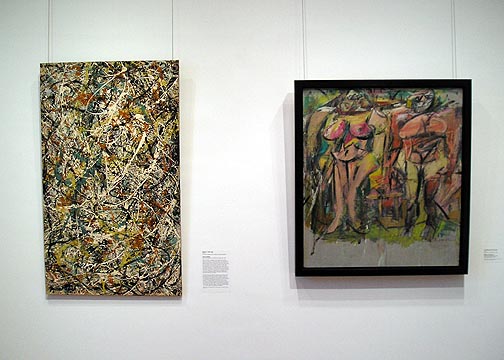
Today, though, many Expressionist painters are more interested in realism and a rather industrial approach to art, as you can see from this acryllic tryptich of sorts.
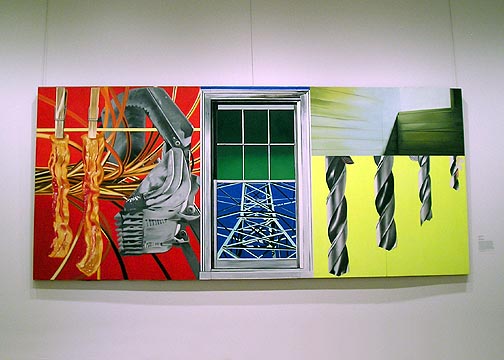
Modern artists are no longer limited to just paint. Here is a wall-sized art work that qualifies as a "multi-media" installation. I've photographed it for you both from the front and from the side so you can see the three-dimensionality of the piece.
Sometimes the three-dimensionality of modern art is much more pronounced. We saw several instances of large, hollow heads which had been cast and painted to look like real heads, then suspended from the ceiling so that they floated in the air.
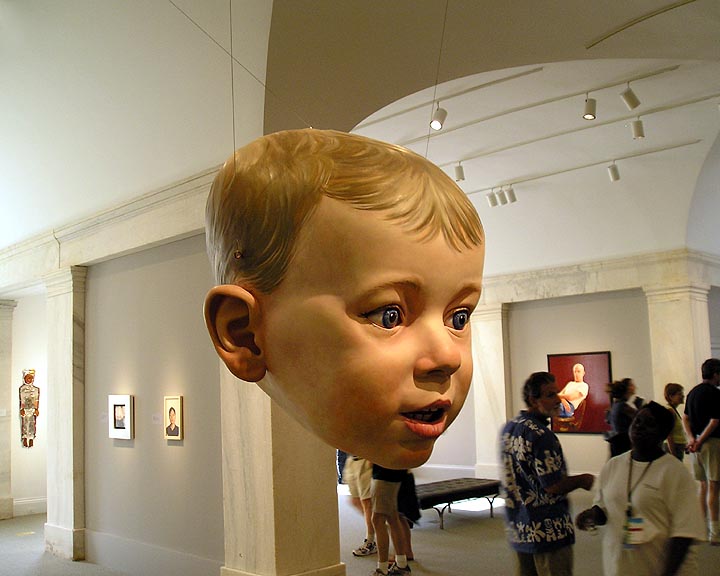
The new collection is also surprisingly current, with art from the 21st century, including this large portrait of actor Christopher Reeve done shortly before his death in 2004 (incidentally, his wheelchair and Superman costume are both in the Smithsonian's collection at another museum).
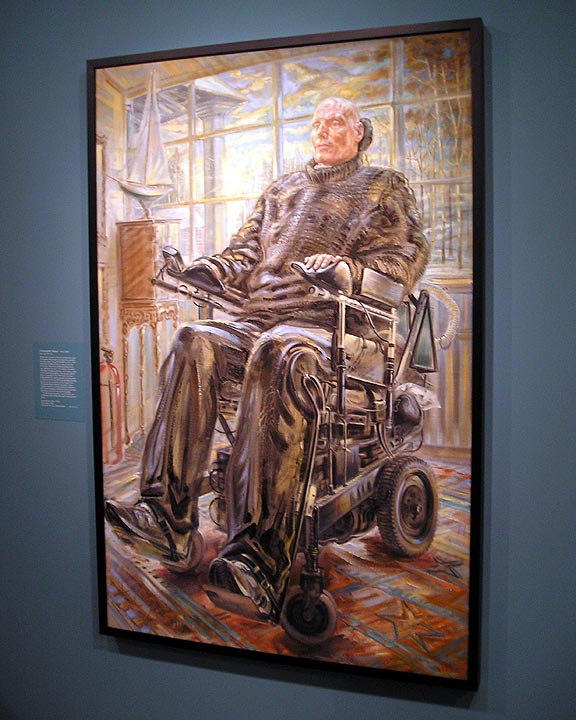
Of course, what would a modern art museum be without something shocking? They have a whole room devoted to the photographic portraiture of controversial artist Andres Serrano, who famously received the ire of Senator Jesse Helms back in 1989 because of his photograph entitled Piss Christ, which depicted a crucifix submerged in a jar of the artist's urine. I was disapointed, though, that neither Piss Christ nor Madonna and Child II, his other highly controversial work, appeared in his room.
Throughout the centuries, art has depicted the female nude form, whether classical statuary or Botticellian nudes or Rubenesque beauties, and modernists are no different. Here is a modern museum painting entitled Saluting the Female Nude. They're a little too small to see, but in the painting's foreground are some military men saluting the central picture.
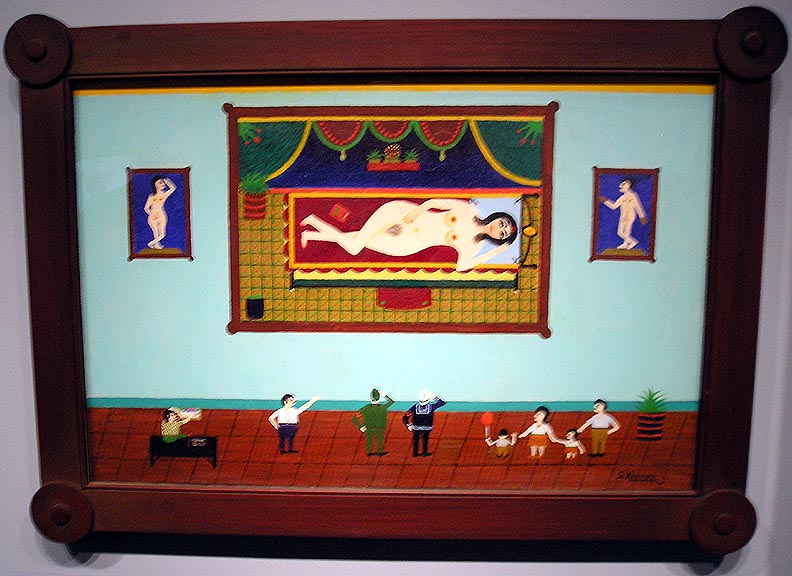
There were also the token contemporary nude art works. On the left is a painting of twin nude males in bed. On the right is a glowing wall artwork called "Mom and Dad" made up of little miniature lightbulbs in a combination honoring of both husband and wife and of the pointillism pioneered in the late 19th century by French artist Georges Seurat.
We also saw several examples of how modern art and architecture merge in modern room design.
Some of the modern art can be fun, too. Here's a work saluting the American information superhighway.
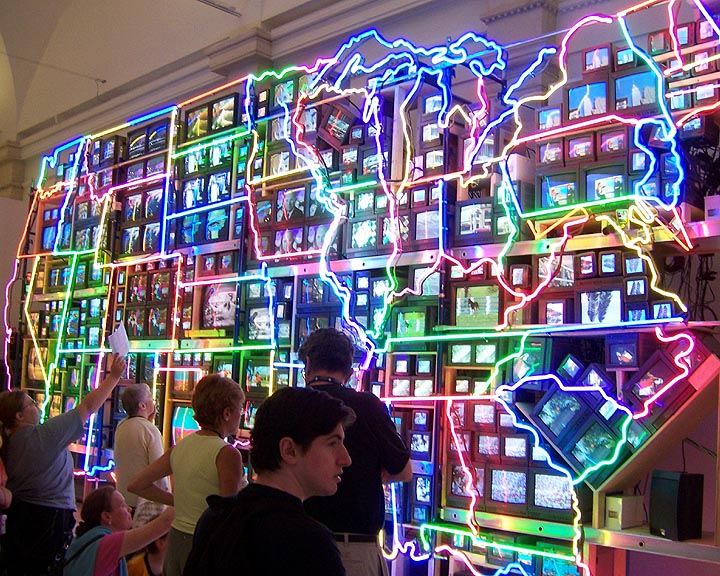
And, finally, here's another crowd pleaser: this wall hanging is a car license plate from every state in the country that has the words that spell out the Preamble to the Constitution of the United States.
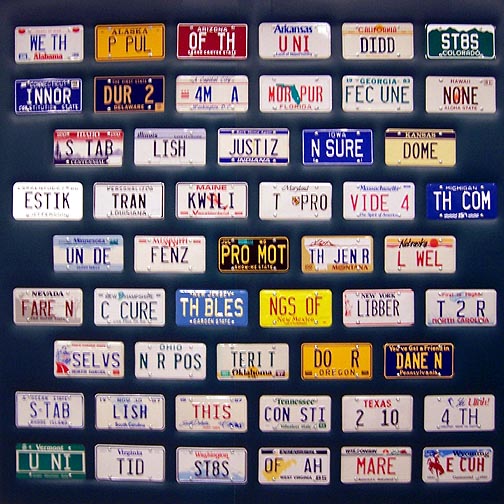
Anyway, modern art is always provocative. Some people like modern art because of the bright colors or the wild designs. There are those who like modernism because it makes the viewer think. Some like the "issues" portrayed by different artists. Many art lovers like the modern idiom because of multi-media projects and installations (not to mention performance art!). Others just like art that doesn't really look like anything.
I don't want to pass judgment or indicate any "favorites." These are just some of the works that caught my eye yesterday.
Modern art is no longer just the Cubists or the Abstract Expressionists, though Expressionism is certainly well-represented at the museum. While they have quite a number of these, here are two of the painting they have by mid-20th century painters Jackson Pollack and Willem de Koonig, who are considered prime exemplars of the style.

Today, though, many Expressionist painters are more interested in realism and a rather industrial approach to art, as you can see from this acryllic tryptich of sorts.

Modern artists are no longer limited to just paint. Here is a wall-sized art work that qualifies as a "multi-media" installation. I've photographed it for you both from the front and from the side so you can see the three-dimensionality of the piece.
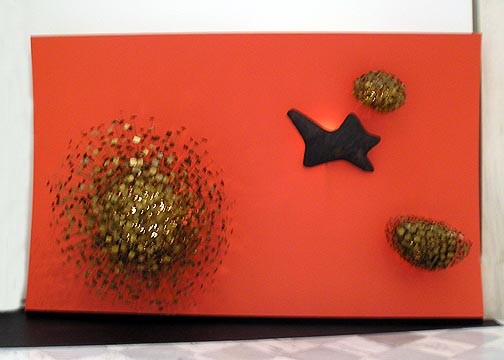 | 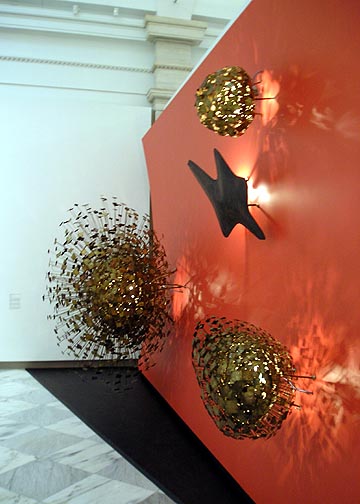 |
Sometimes the three-dimensionality of modern art is much more pronounced. We saw several instances of large, hollow heads which had been cast and painted to look like real heads, then suspended from the ceiling so that they floated in the air.

The new collection is also surprisingly current, with art from the 21st century, including this large portrait of actor Christopher Reeve done shortly before his death in 2004 (incidentally, his wheelchair and Superman costume are both in the Smithsonian's collection at another museum).

Of course, what would a modern art museum be without something shocking? They have a whole room devoted to the photographic portraiture of controversial artist Andres Serrano, who famously received the ire of Senator Jesse Helms back in 1989 because of his photograph entitled Piss Christ, which depicted a crucifix submerged in a jar of the artist's urine. I was disapointed, though, that neither Piss Christ nor Madonna and Child II, his other highly controversial work, appeared in his room.
Throughout the centuries, art has depicted the female nude form, whether classical statuary or Botticellian nudes or Rubenesque beauties, and modernists are no different. Here is a modern museum painting entitled Saluting the Female Nude. They're a little too small to see, but in the painting's foreground are some military men saluting the central picture.

There were also the token contemporary nude art works. On the left is a painting of twin nude males in bed. On the right is a glowing wall artwork called "Mom and Dad" made up of little miniature lightbulbs in a combination honoring of both husband and wife and of the pointillism pioneered in the late 19th century by French artist Georges Seurat.
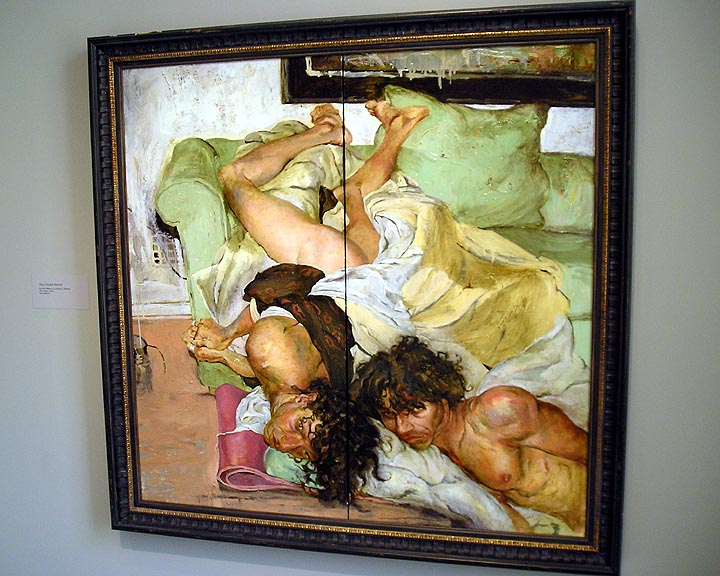 | 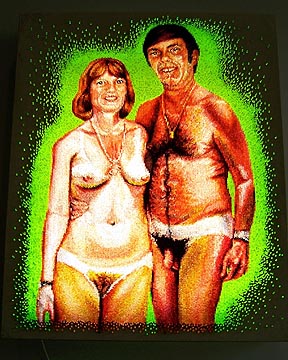 |
We also saw several examples of how modern art and architecture merge in modern room design.
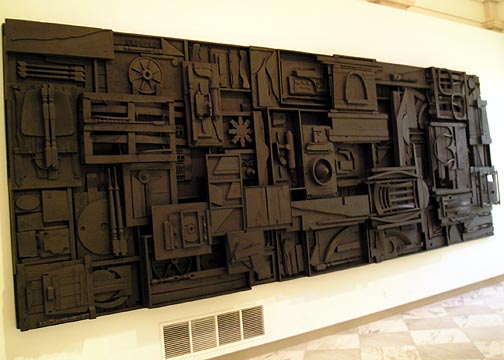 | 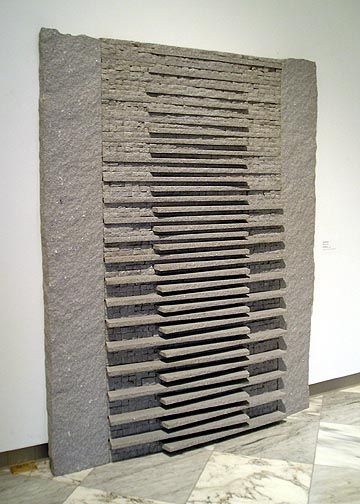 |
Some of the modern art can be fun, too. Here's a work saluting the American information superhighway.

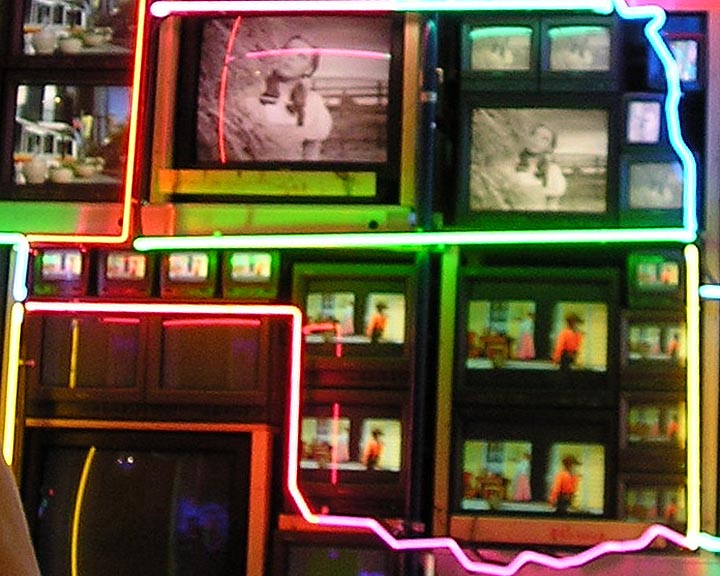 | Here's a closeup of that big neon map. You'll notice that behind each state are a series of small video monitors. Each monitor shows films loops from movies or newscasts which are appropriate to that particular state. See The Wizard of Oz playing in Kansas and Oklahoma! playing in Oklahoma? |
And, finally, here's another crowd pleaser: this wall hanging is a car license plate from every state in the country that has the words that spell out the Preamble to the Constitution of the United States.

Museum sculpture
The National Portrait Gallery and Smithsonian American Art Museum both have a lot of sculptures in their collections. The Portrait Gallery's things tend to be much more traditional—bronze, marble, etc.—and classical in style, while the things in the American Art Museum tend to be strikingly contemporary and at times even shocking. Here are a few things we found interesting.
Some of the things are what you'd see in most any museum.
Then, when we get to the modern sculptures, things become more stylized and symbolic, rather than literal. Here's a sculpture depicting the arrest of civil rights figure Rosa Parks.
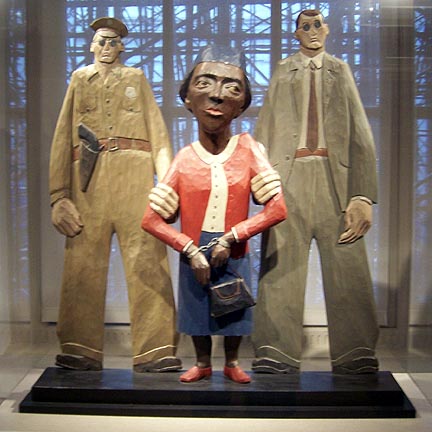
We also see a lot of traditional concepts being re-realized in the modern idiom.
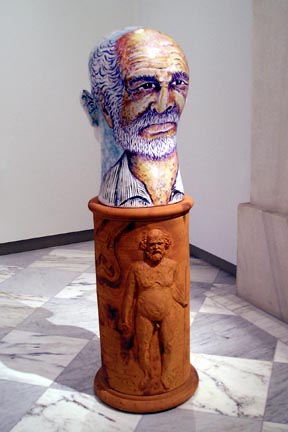
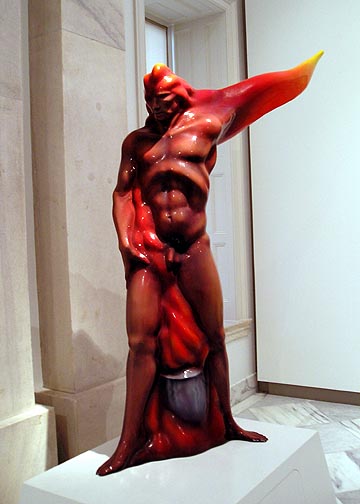
And, of course, there is a lot of "modern" sculpture which is abstract and which can't really be identified or described other than just amorphous figures.
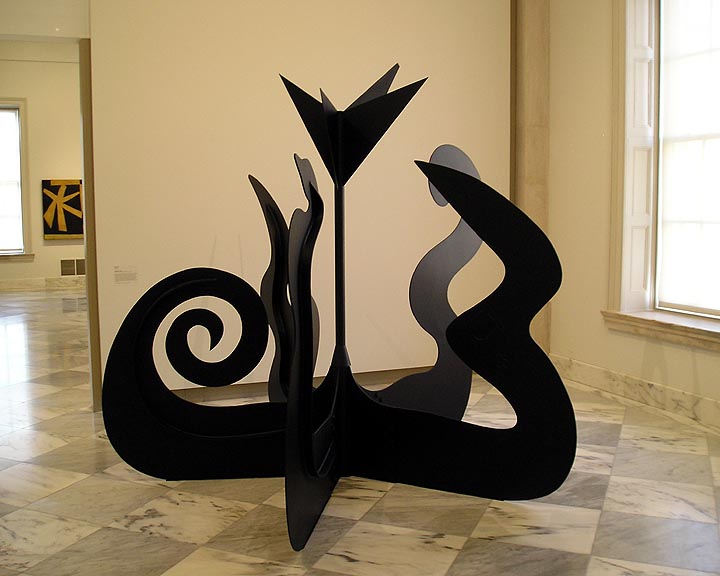
We also found some almost lifelife sculptures made of wax—after all, Madame Toussaud has been doing it for decades, why can't modern artists? Many people walk by this sculpture and think it's a real person.
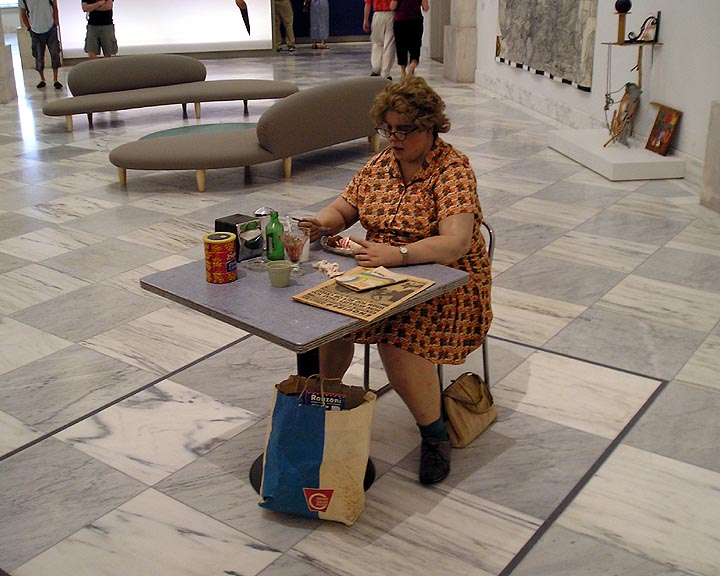
Some of the things are what you'd see in most any museum.
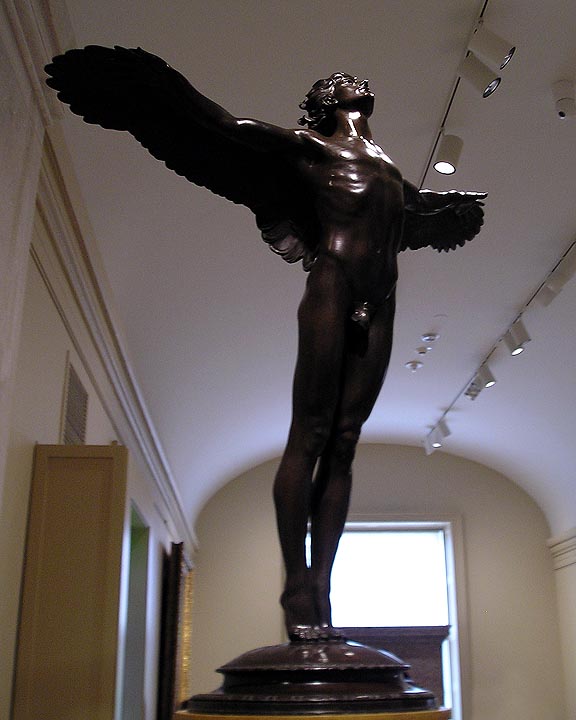 | 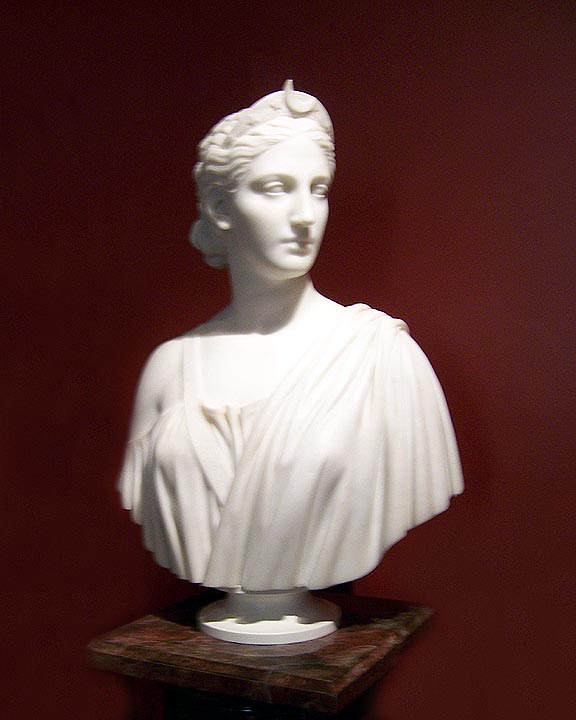 | 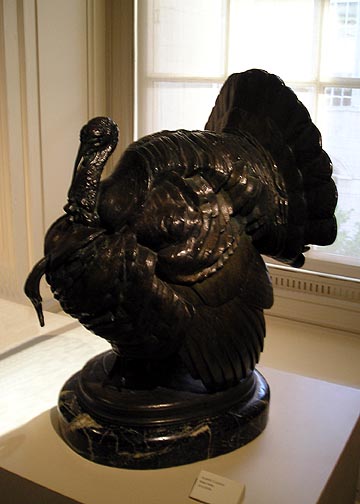 |
Then, when we get to the modern sculptures, things become more stylized and symbolic, rather than literal. Here's a sculpture depicting the arrest of civil rights figure Rosa Parks.

We also see a lot of traditional concepts being re-realized in the modern idiom.


And, of course, there is a lot of "modern" sculpture which is abstract and which can't really be identified or described other than just amorphous figures.

We also found some almost lifelife sculptures made of wax—after all, Madame Toussaud has been doing it for decades, why can't modern artists? Many people walk by this sculpture and think it's a real person.

Museum presidents
The National Portrait Gallery has an official collection of the portraits of every president. The presidential gallery is artfully displayed with not only the official portrait, but other paintings, photographs, and even newsreels. A couple of them I found interesting,
This is Norman Rockwell's portrait of Richard Nixon, and one of the best paintings in the gallery.
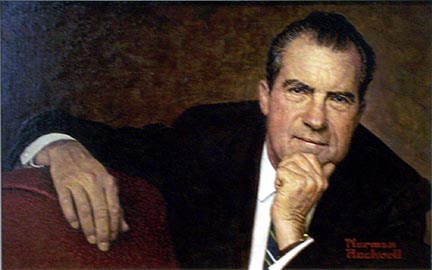
Here is one of the alternative portraits of Abraham Lincoln, but I think I actually like this one better than the standard one everybody sees all the time.
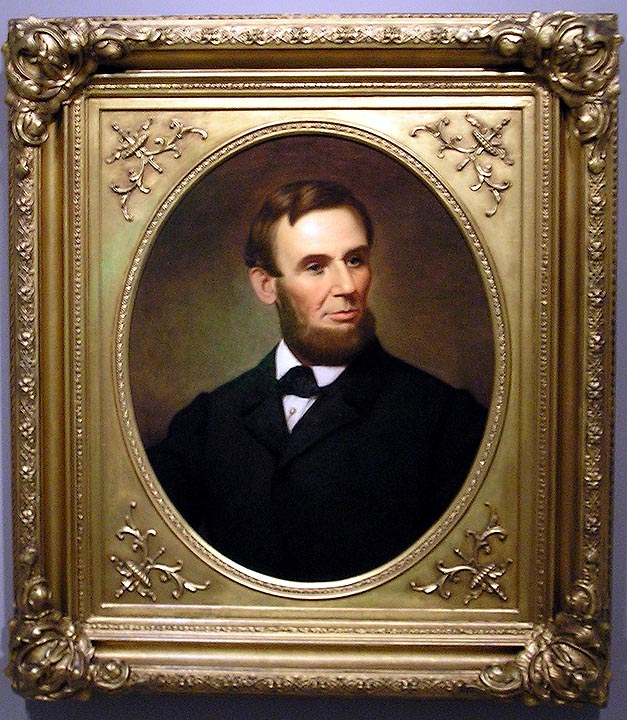
Lincoln is also the subject of two historic photographs. The first of these photographs was taken by the renowned photographer Matthew Brady and was often seen in Lincoln's presidential campaign. The second photograph was taken after the Civil War and shortly before Lincoln's death.
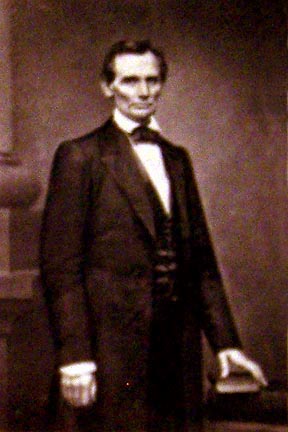
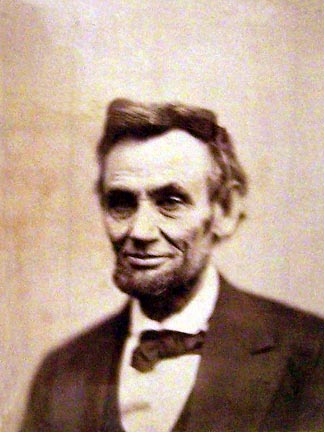
This is Norman Rockwell's portrait of Richard Nixon, and one of the best paintings in the gallery.

Here is one of the alternative portraits of Abraham Lincoln, but I think I actually like this one better than the standard one everybody sees all the time.

Lincoln is also the subject of two historic photographs. The first of these photographs was taken by the renowned photographer Matthew Brady and was often seen in Lincoln's presidential campaign. The second photograph was taken after the Civil War and shortly before Lincoln's death.


Museum furniture
Not all of the art we use is a sculpture or a painting. Some of it is designed to be both beautiful and utilitarian, and fine furniture is one of those art forms. The Smithsonian American Art Museum has a number of examples of fine, early 19th century American furniture. I've always loved this style of furniture, but the better pieces from that era are pretty pricey. Anyway, behind the cut are some pictures of their furniture.
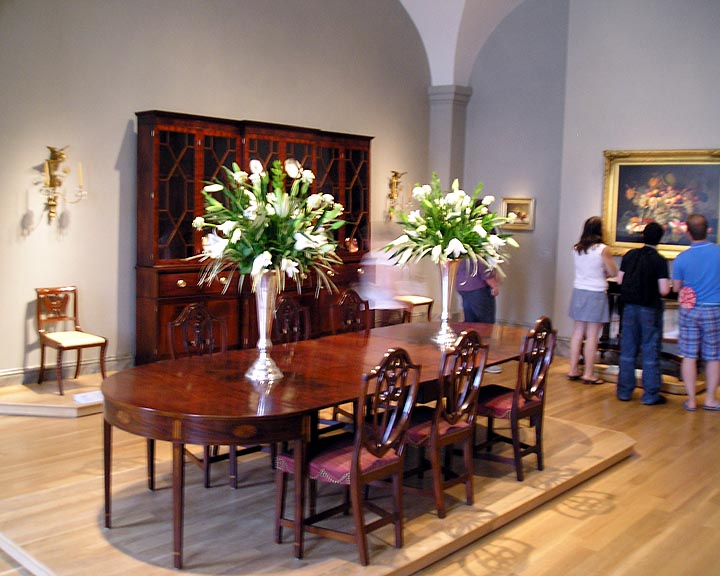
(Yes, the flowers are real!
There is a lot of striking modern furniture in the modern galleries which is actually intended for use.
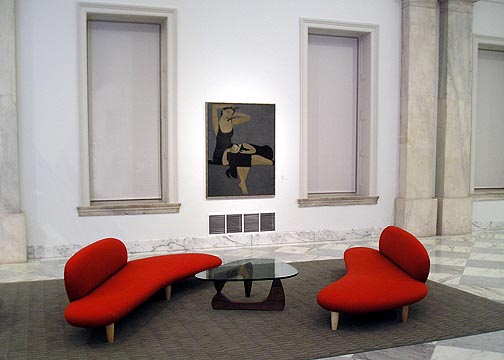

(Yes, the flowers are real!
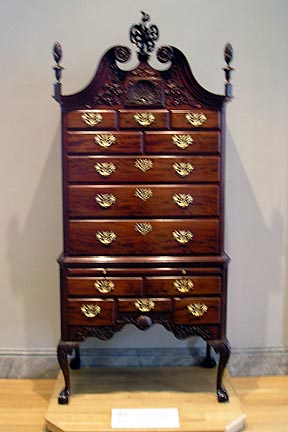 | 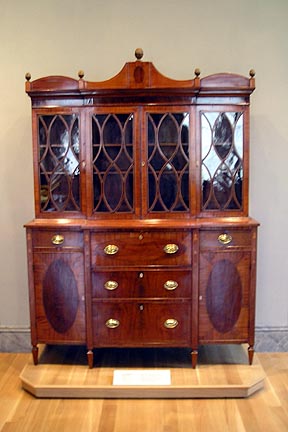 | 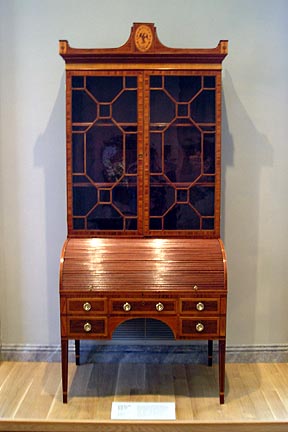 |
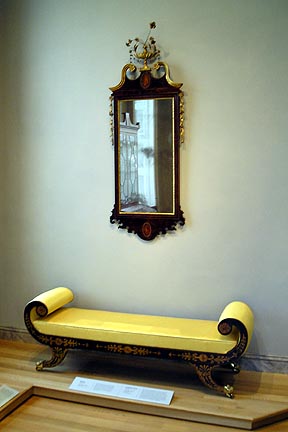 | 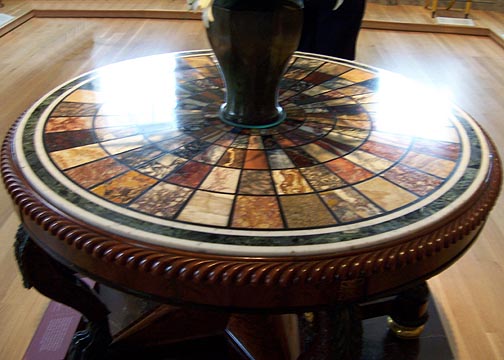 |

Subscribe to:
Posts (Atom)
